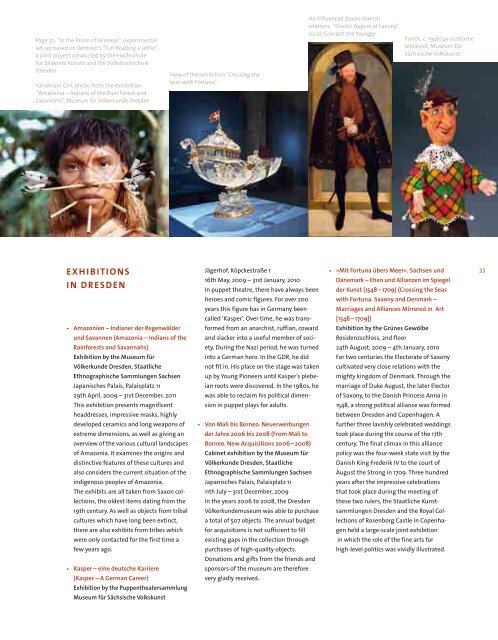Annual Report 2010 - Staatliche Kunstsammlungen Dresden
Annual Report 2010 - Staatliche Kunstsammlungen Dresden
Annual Report 2010 - Staatliche Kunstsammlungen Dresden
You also want an ePaper? Increase the reach of your titles
YUMPU automatically turns print PDFs into web optimized ePapers that Google loves.
Page 32: “in the Prism of Vermeer”, experimental<br />
set-up based on Vermeer’s “Girl reading a Letter”,<br />
a joint project conducted by the Hochschule<br />
für Bildende Künste and the Volkshochschule<br />
<strong>Dresden</strong><br />
Yanomani Girl, photo from the exhibition<br />
“amazonia – indians of the rain Forest and<br />
savannahs”, Museum für Völkerkunde <strong>Dresden</strong><br />
eXH I B ItIonS<br />
I n DReSDen<br />
• Amazonien – Indianer der Regenwälder<br />
und Savannen (Amazonia – Indians of the<br />
Rainforests and Savannahs)<br />
Exhibition by the Museum für<br />
Völkerkunde <strong>Dresden</strong>, <strong>Staatliche</strong><br />
Ethnographische Sammlungen Sachsen<br />
Japanisches Palais, Palaisplatz 11<br />
29th April, 2009 – 31st December, 2011<br />
This exhibition presents magnificent<br />
headdresses, impressive masks, highly<br />
developed ceramics and long weapons of<br />
extreme dimensions, as well as giving an<br />
overview of the various cultural landscapes<br />
of Amazonia. It examines the origins and<br />
distinctive features of these cultures and<br />
also considers the current situation of the<br />
indigenous peoples of Amazonia.<br />
The exhibits are all taken from Saxon collections,<br />
the oldest items dating from the<br />
19th century. As well as objects from tribal<br />
cultures which have long been extinct,<br />
there are also exhibits from tribes which<br />
were only contacted for the first time a<br />
few years ago.<br />
• Kasper – eine deutsche Karriere<br />
(Kasper – A German Career)<br />
Exhibition by the Puppentheatersammlung<br />
Museum für Sächsische Volkskunst<br />
View of the exhibition “Crossing the<br />
seas with Fortuna”<br />
Jägerhof, Köpckestraße 1<br />
16th May, 2009 – 31st January, <strong>2010</strong><br />
In puppet theatre, there have always been<br />
heroes and comic figures. For over 200<br />
years this figure has in Germany been<br />
called ‘Kasper’. Over time, he was transformed<br />
from an anarchist, ruffian, coward<br />
and slacker into a useful member of society.<br />
During the Nazi period, he was turned<br />
into a German hero. In the GDR, he did<br />
not fit in. His place on the stage was taken<br />
up by Young Pioneers until Kasper’s plebeian<br />
roots were discovered. In the 1980s, he<br />
was able to reclaim his political dimension<br />
in puppet plays for adults.<br />
• Von Mali bis Borneo. Neuerwerbungen<br />
der Jahre 2006 bis 2008 (From Mali to<br />
Borneo. New Acquisitions 2006 – 2008)<br />
Cabinet exhibition by the Museum für<br />
Völkerkunde <strong>Dresden</strong>, <strong>Staatliche</strong><br />
Ethnographische Sammlungen Sachsen<br />
Japanisches Palais, Palaisplatz 11<br />
11th July – 31st December, 2009<br />
In the years 2006 to 2008, the <strong>Dresden</strong><br />
Völkerkundemuseum was able to purchase<br />
a total of 507 objects. The annual budget<br />
for acquisitions is not sufficient to fill<br />
existing gaps in the collection through<br />
purchases of highquality objects.<br />
Donations and gifts from the friends and<br />
sponsors of the museum are therefore<br />
very gladly received.<br />
He influenced saxon-Danish<br />
relations: “Elector august of saxony”,<br />
Lucas Cranach the Younger<br />
Punch, c. 1946/49 (costume<br />
replaced), Museum für<br />
sächsische Volkskunst<br />
• »Mit Fortuna übers Meer«. Sachsen und<br />
Dänemark – Ehen und Allianzen im Spiegel<br />
der Kunst (1548 – 1709) (Crossing the Seas<br />
with Fortuna. Saxony and Denmark –<br />
Marriages and Alliances Mirrored in Art<br />
[1548 – 1709])<br />
Exhibition by the Grünes Gewölbe<br />
Residenzschloss, 2nd floor<br />
24th August, 2009 – 4th January, <strong>2010</strong><br />
For two centuries the Electorate of Saxony<br />
cultivated very close relations with the<br />
mighty kingdom of Denmark. Through the<br />
marriage of Duke August, the later Elector<br />
of Saxony, to the Danish Princess Anna in<br />
1548, a strong political alliance was formed<br />
between <strong>Dresden</strong> and Copenhagen. A<br />
further three lavishly celebrated weddings<br />
took place during the course of the 17th<br />
century. The final climax in this alliance<br />
policy was the fourweek state visit by the<br />
Danish King Frederik IV to the court of<br />
August the Strong in 1709. Three hundred<br />
years after the impressive celebrations<br />
that took place during the meeting of<br />
these two rulers, the <strong>Staatliche</strong> <strong>Kunstsammlungen</strong><br />
<strong>Dresden</strong> and the Royal Collections<br />
of Rosenborg Castle in Copenhagen<br />
held a largescale joint exhibition<br />
in which the role of the fine arts for<br />
highlevel politics was vividly illustrated.<br />
33

















